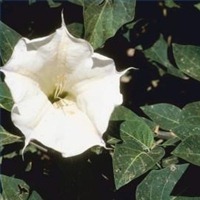Datura, also know as jimsonweed and angel’s trumpet, is an annual flower belonging to the Solanaceae family. The striking, trumpet-shaped blooms and serrated foliage add interest to moon gardens, patio containers and indoor collections. Though beautiful to admire, datura plants are highly toxic to humans and animals, who should not have easy access to gardens where datura grows. Datura varieties, which grow best in full sun and well-draining soil, reach 4 to 6 feet in height, with blooms in shades of white, yellow, red and purple.
Difficulty: Moderately Easy
Instructions
Things You’ll Need:
- Sharp knife or pruning snips
- Paper towels
- Tray or container
- Sterile potting mix
- Seed trays or pots
- Plastic wrap or plastic bags
- Bamboo stakes or sturdy drinking straws
-
Choose branches from the current season’s growth on the upper portion of the plant. The North Carolina Cooperative Extension Service recommends avoiding branches containing flowers or buds.
-
Cut a 4- to 6-inch piece from the parent plant, using a sharp knife or pruning snips. Take cuttings in the morning hours when plants are fully hydrated.
-
Place cuttings in a container and cover with moistened paper towels until you are ready to transplant. For best results, transplant cuttings immediately after removal from the parent plant.
-
Fill transplant containers (pots or seed trays) with slightly moistened potting mix.
-
Place a small amount of rooting hormone in a bowl or container other than the original jar. This prevents contamination of the original jar should the cutting be carrying any disease.
-
Remove any buds, flowers and foliage from the bottom half of the stem and peel away a small portion of bark from the cut end to expose the soft cambium tissue. This will encourage easier development of roots.
-
Dip the stems in water and then into the rooting hormone, coating the cut end completely. Discard any unused rooting hormone when you are finished transplanting.
-
Insert each stem into the potting soil to a depth of at least 1/3 to 1/2 of its length, keeping the stem in a vertical position.
-
Water each stem lightly; insert a straw or stake into the corner of each tray and then cover with plastic wrap or a plastic bag to help retain moisture during the rooting process.
-
Place the datura cuttings in indirect light and mist with water regularly to keep soil moist but not saturated.
-
Check cuttings for root development by giving each stem a gentle tug. If it shows resistance, roots are forming. If the cutting pulls free of the soil, check it for rot or disease and discard any unhealthy specimens. If the cutting is healthy, return it to the soil and give it some more time for root development.
-
Transplant rooted datura cuttings to larger pots to allow further growth before moving them to their final location.
Tips & Warnings
-
Take semi-hardwood cuttings in late summer to early fall when wood is firm and leaves are mature.


Deprecated: strpos(): Passing null to parameter #1 ($haystack) of type string is deprecated in /home/agriviek8Qv/agriviet.net/public_html/wp-includes/comment-template.php on line 2522